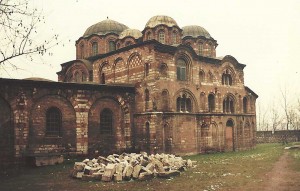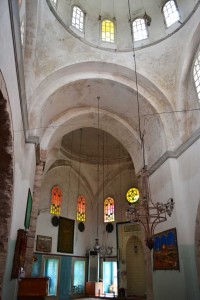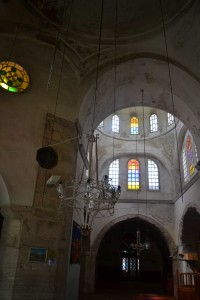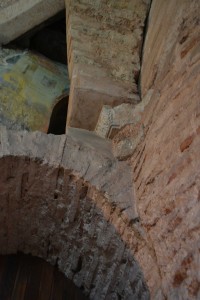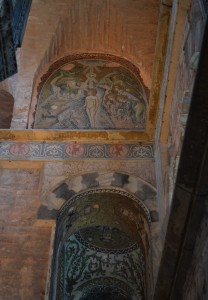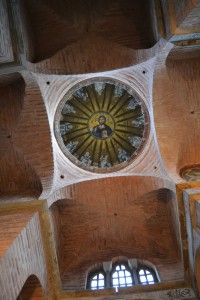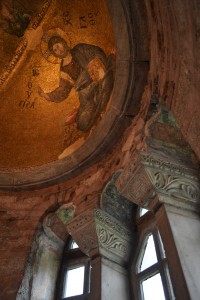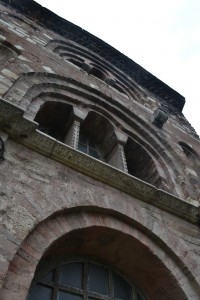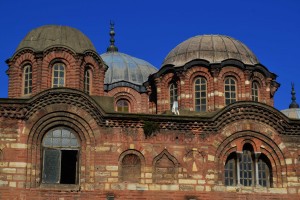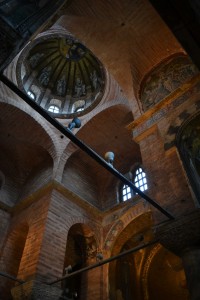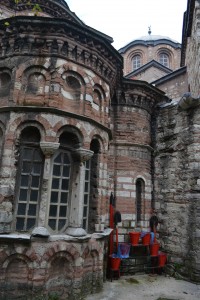This is a picturesque church with a strange, rambling shape because of the many additions and modifications it has endured. It has a multiplicity of domes of different sizes, which gives it something of a fairytale appearance.
Unlike most of the other major churches in the district, it is hard to find by simply bumbling around. It is at the end of Fethiye Kapısı Sokak, a turn-off from Fethiye Caddesi downhill from the Selimiye. (41.02881,28.946164). The larger part of the existing building is once more in use as a rather austere mosque. It is always open, unlike the museum part which is closed on Wednesdays. The museum is the parekklesion, or side chapel, that houses the mosaics, far less extensive than in Kariye but just as lovely.
Mamboury suggests that the church was built in the 8th century but adds that the original church is hard to recognise. So much so that most archaeologists date its foundation to the 11th or 12th century. This refers to the older church that is now a mosque. The parekklesion was added to the south of the church in the 13th century as a memorial chapel to one of Andronikus II’s generals. The richness of the shrine gives some idea of how lucrative being a general must have been.
This church was the Patriarchate for a while. The great Patriarch Gennadius, who was apparently consulted on matters of theology by the conquering Sultan Mehmet, moved his HQ here in 1456 from the decrepit Church of the Holy Apostles, the site of which was required by Fatih for his fabulous new mosque. In about 1586, Sultan Murat III decided that this church too was to become a mosque so the patriarchate moved down the hill to the Church of Theotokos Paramythia (Vlach Saray). The conversion to a mosque resulted in the walls between separate buildings and chambers being knocked down and a sort of triangular bit being built on to enable a mihrab to face Mecca. This made a much more open structure but created a puzzle for the Byzantine Institute in their preparation for the restoration in 1949.
The mosaics were considered by Mamboury to be superior to those in Kariye. There are traces of frescoes remaining but these have largely been destroyed in the various remodellings that the building has endured.
Only one mosaic remains from what appears to have been a life-of-Christ series similar to the example in Kariye. This displays the baptism of Christ in a slightly surprising full-frontal format.
In the arches and small domes on the south side of the church are portrait mosaics of saints, including a fine one of Gregory the Illuminator, driving force behind the Armenian church.
In the semi-dome of the apse is a lovely mosaic of Christ Hyperagathos, said by Freely to mean ‘all-loving’ but more commonly interpreted, as in the Dumbarton Oaks literature on the church, as ‘supremely good’. This appears to be an attempt to depict the concept of John Scotius Eriugena’s 9th century concept of ‘more than goodness‘. This masterpiece is flanked by full-length representations of John the Baptist and Mary, the Theotokos Pammakaristos to whom the main church was dedicated.
In the dome is the traditional Christ Pantocrator (the all-powerful), in this example surrounded by twelve prophets of the Old Testament – Moses, Jeremiah, Zephaniah, Micah, Joel, Zechariah, Obadiah, Habbakuk, Jonah, Malachi, Ezekiel and Isaiah. Some interesting choices in that list.
The mosaics that remain are marvellous in their own right but give a tantalising glimpse of what must have been a magnificent work of art in its totality.
There is a long inscription of a dedicatory poem by Manuel Philes, both on both the inside and outside of the church. Van Millingen provides a translation of this in his definitive 1912 work on Byzantine churches. He also provides some pictures of the church before the Dumbarton Oaks restoration.

Categories: Uncategorized | No Comments »
